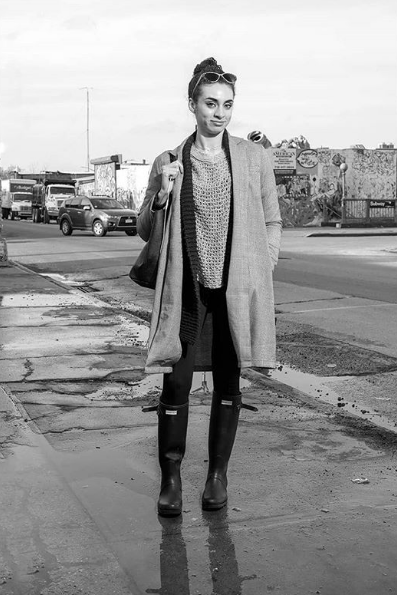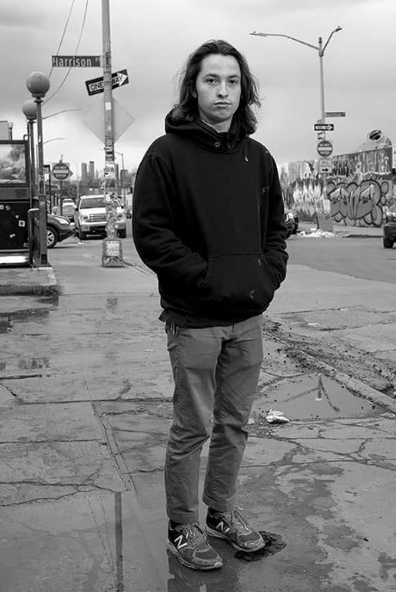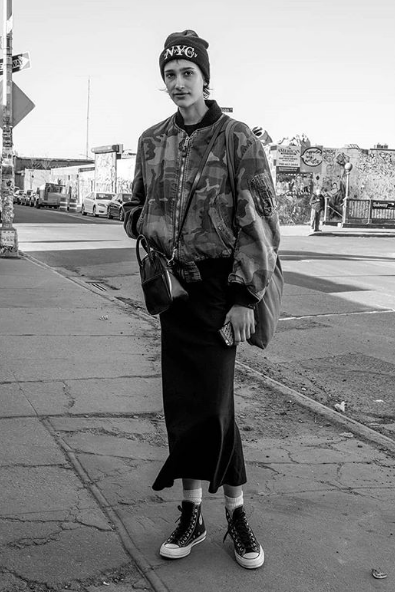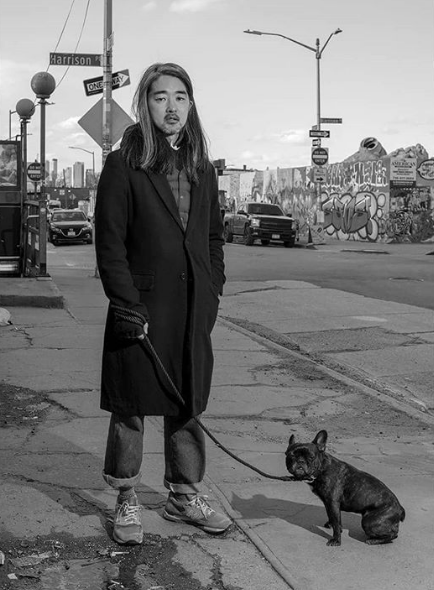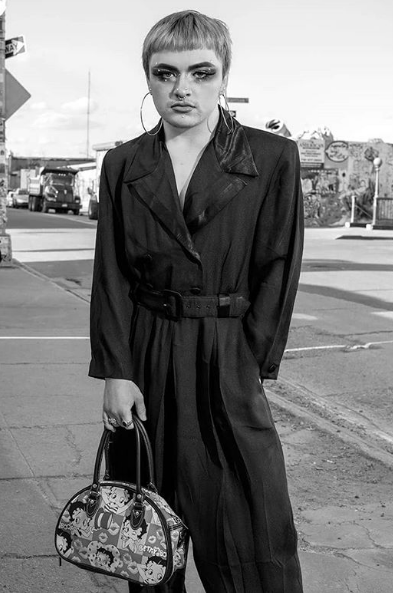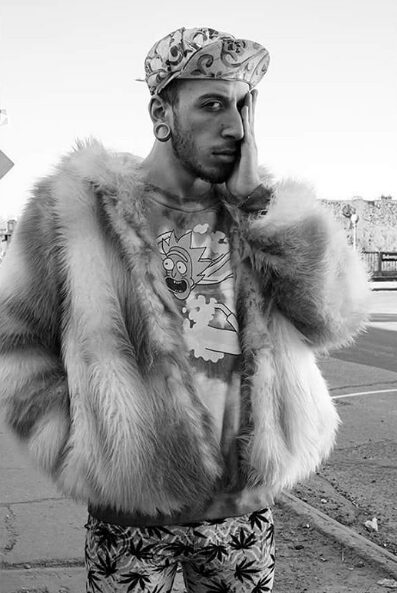
A Moment Shared With Matias Aguilar, Bushwick Street Photographer
A couple of Mondays ago marked a typical, metaphoric sigh of the new week, made worse by a number of slight day-to-day inconveniences of life in NYC. The day’s trials and tribulations included unwarranted gusts of wind (the side effect of some cruel amalgamation of winter and spring weather), misplaced packages, and delayed trains. Needless to say, getting back to my cozy apartment was my main priority after exiting the aforementioned train. But to my surprise, someone was waiting just outside of the subway entrance. I heard him through my headphones — which, as many who live in this city can attest to, are used in part as a “don’t talk to me” mechanism — and he greeted me with a simple question: “Can I take your picture?”
I hesitated; in that moment, I wanted nothing more than to be home after my long, exhausting day. He later admitted that he can generally tell those who will agree to having their picture taken from those who won’t, and he suspected that I would be the latter. Perhaps prompted by this intuition, he quickly introduced himself with three vital pieces of information: his name is Matias, he is a street photographer working on a portrait series and no, this would not take long. I wondered why (and admittedly, was flattered that) he wanted to take a picture of me. In a moment of spontaneity, I agreed.
With little experience in front of the camera (usually, I’m on the other side of it or writing about who’s in front of it!), I was suddenly very aware of my body and consequently, unsure of how to present it. Matias instructed me to act “as I normally do,” later explaining that this sense of duality was common when being photographed. A flash, attached by a GorillaPod to a nearby street post, went off as I stood “normally” and no more than 3 frames later, it was done. To capture the authenticity of a moment, Matias tries to photograph it in two frames — sometimes three, in one instance four, but never more than five. He then pulled his phone from his pocket, showing me his Instagram page that would soon encapsulate our encounter in a small, square frame. The page was filled with striking black-and-white portraits that captured the full range of emotion, from sheepish smirks to stone-faced stoicism. We talked for a short while — mainly to address my curiosity about the typical reaction to being photographed — and though brief, our conversation was rich and would become one of many.
There is a certain mysticism to someone paying attention to you in the intense, intimate way that portrait photography requires, and this is only amplified when the expectation of a return is nothing more than to share a moment. Validation has a way of turning a bad day around, and the positive feeling from my encounter with Matias lingered. I didn’t go home, opting instead for a nearby café. My priority had shifted; I pulled my laptop out and researched the mysterious photographer.
In short, Matias Aguilar is a multifaceted artist and the walking American dream. He studied painting first where he was born, then where he was raised, and finally where he relocated; the Philippines, Germany, and New York, respectively. Broadening his horizons, he began to sculpt and in taking pictures of his artwork, began to photograph. Accomplishing what many dream to, he became successful through his art — he has been featured in Jersey City Museum, Longwood Arts Project, and the Center for Book Arts. He now lives and works in Clinton Hill (an area that he, as divulged during later conversations, loves!). But the autobiography on his website painted his life in broad strokes, and I wanted to know more: why is he shooting a street photography portrait series and, perhaps selfishly, why did he photograph me? I sent him an email asking if he would tell his story and, in a matter of hours, he replied.
We met at the end of the week — on a Sunday much calmer than the Monday of our initial introduction — and over a cup of coffee, he shared his story. It is genuine, humbling, and nothing short of fascinating. The following is our conversation (edited for time and clarity):
Michelle Darris: When did you begin with your photography?
Matias Aguilar: 12 years ago right here in New York City. I was doing mostly sculpture and video at the time. I was unhappy with my art. Things were not really happening the way I intended. The effort of making art was immense and not sustainable. I needed a break. I booked a trip to Memphis and went to visit Graceland; that was my first photo series. And from then on I would always bring my camera everywhere I go. The idea was to travel to a lot of places in this country. Growing up, I had often imagined how life in America would be like. In my pictures I explored being here as a reflection. I wanted to pair imagination with reality. I always loved culture and music. That’s why Memphis, the birthplace of rock and roll, was a great place to start. Am I talking too much now?
MD: No, tell me more!
MA: But because of my job and the necessity to make an income, I ended up not traveling much at all. I needed to pay bills. So here I was in the city shooting mostly street photography. I liked the results, but I was always looking for new challenges and directions. Early this year, I decided to ask people in the street in Bushwick to take their portrait. I immediately loved to involve my subjects face to face this way. I get to talk to interesting people in an interesting neighborhood these days. It reminds me of the time when I moved to New York and how fresh it all felt. I never made friends so fast.
MD: Do people react well when you ask if you can photograph them, do they normally say “Yes!” or what is the reaction like?
MA: Of course a few will decline, but I almost never got a super negative reaction. Nobody would say “Hey, what are you doing out here? Stop this!” I think I can sense in the body language or facial expressions of a person if he or she does not want their picture to be taken. But I am often proven wrong. I learned that by default we isolate ourselves. Our minds travel, and we easily get absorbed by our daily challenges. In such a state we probably do not appear very inviting. I am often struck how people utterly change once you take them out of that zone with just a few words.
MD: Do you remember the most interesting encounter you’ve had for your portrait series specifically?
MA: That’s really hard to say. I’m a little overwhelmed in these situations because I work by myself and also have to talk to strangers at the same time . A lot of photographers really dread that, I probably did, too. Let me think of my most interesting… There was a young guy in his twenties riding on a skateboard carrying two suitcases. That was just an amazing moment to witness. It said so much about Bushwick. I just had to ask him if I could take his picture. Often, it feels funny to see people whose picture I have taken again. It is an awkward situation. And then I’ll tell them “Hey, did you see your picture?” Often they haven’t, so I show them the portrait on my Instagram. They would look at it and be like “Oh, it’s really nice!” This kind of interaction with people means a lot to me. I love it when they request the image and post it on their own Instagram. It is a special moment when I sense happiness.
MD: I can definitely attest to that, I know when you took my picture it made my day. I was kind of having a down day, just going home, and then for somebody to want to take my picture– there’s something powerful about somebody wanting to give you that attention, not really to receive anything but just for the sake of that interaction. There’s something really powerful, and I think really beautiful, about that, as well. So, why that location? What made you decide to shoot there?
MA: I love the neighborhood. The place I needed to find had to be a typical Bushwick street. I wanted it to be a little remote to avoid much attention. The company I work for is really close by. They moved here 2 years ago from Manhattan. Photographers struggle with the fact that literally everything in Manhattan has been photographed already. This is not necessarily the case in Bushwick. It feels fresher here. The area has been changing drastically, too. That is exciting.
MD: Why did you choose to shoot in black and white?
MA: I’ll make this really short. When you tell a visual story and plan on using color, then you burden yourself with a second, additional story to tell. If your color is off, your picture and your story suffers. I like characters and like to be on point telling a story. For my recent portraits, I see color as a distraction.
MD: I like that, it seems very pure. Taking color out makes people focus on what you want them to focus on. So, a more technical question: what kind of camera do you use, and what lens?
MA: Right now for my new series, I use the Nikon D810, and a Nikon 50mm F1.8 G lens. It’s actually one of the cheaper Nikon kit lenses. Stepped down it is mad sharp. In addition, I use one wireless triggered speed light mounted on a street post with a GorillaPod. Occasionally, I use a second handheld flash.
MD: What type of mood are you trying to convey in your series, if any at all? I know the black and white has a sense of purity, but it also does convey a different type of mood than a color photograph would.
MA: I think it’s being alone. We may not want to live our lives being alone, but we certainly experience it that way. There’s a melancholy to some of these pictures, especially in winter when it is cold and dark. I like to isolate my characters. Simplicity and reduction is the key to limit the frames I take. I usually only need to take two or three frames. I rarely take more.
MD: Earlier in our conversation, you had mentioned when you were doing your photography around Memphis, how it was sort of a reflection on what you thought it (this country) would be — how does it live up to what you thought it would have been?
MA: It’s kind of funny because I once wrote as a statement: “I should be as American as apple pie, already.” But it is not that simple. A lot of people have known me since I was a kid and to them, I’m not; they’re like “No, you’re not.” I’d be like “What do you mean, I’ve been here 22 years!” And they’re still like “No!” Becoming and being American is a process — at this point, I do not think about it that much anymore because I see this country’s changing so much anyway. Demographics show us that this place is completely changing from what it was in the ‘90s when I came here, and I think that’s all good. You’re seeing change and you’re seeing society evolve, and I think that’s what counts.
We talked a while after the interview, beyond my premeditated questions and beyond the formality of recording his answers. Matias had spoken about the definitive moment where he decided to, rather than being a removed entity, insert himself into the heart of his project. It occurred to me that writing a profile on him would inevitably put me in the same position. Formal education often teaches journalists to be a fly on the wall, of sorts: we should be present and observing, but not overinvolved with what we are reporting on. However, this piece follows suit with the unexpected nature of our original meeting because it, too, is serendipitous. To leave the story of Matias’ past and his outlook on the future unwritten would have been an injustice.
Some time later, our coffee was gone and it was time to part ways. I stayed to begin writing my piece, and Matias left to go back to Clinton Hill — I’m sure to, as I’d described in the closing line of the very email that had allowed for this interview, “keep making art and putting smiles on strangers’ faces.”
These are only a few of my favorites — check out Matias’ Instagram page to see more of his portrait series!



